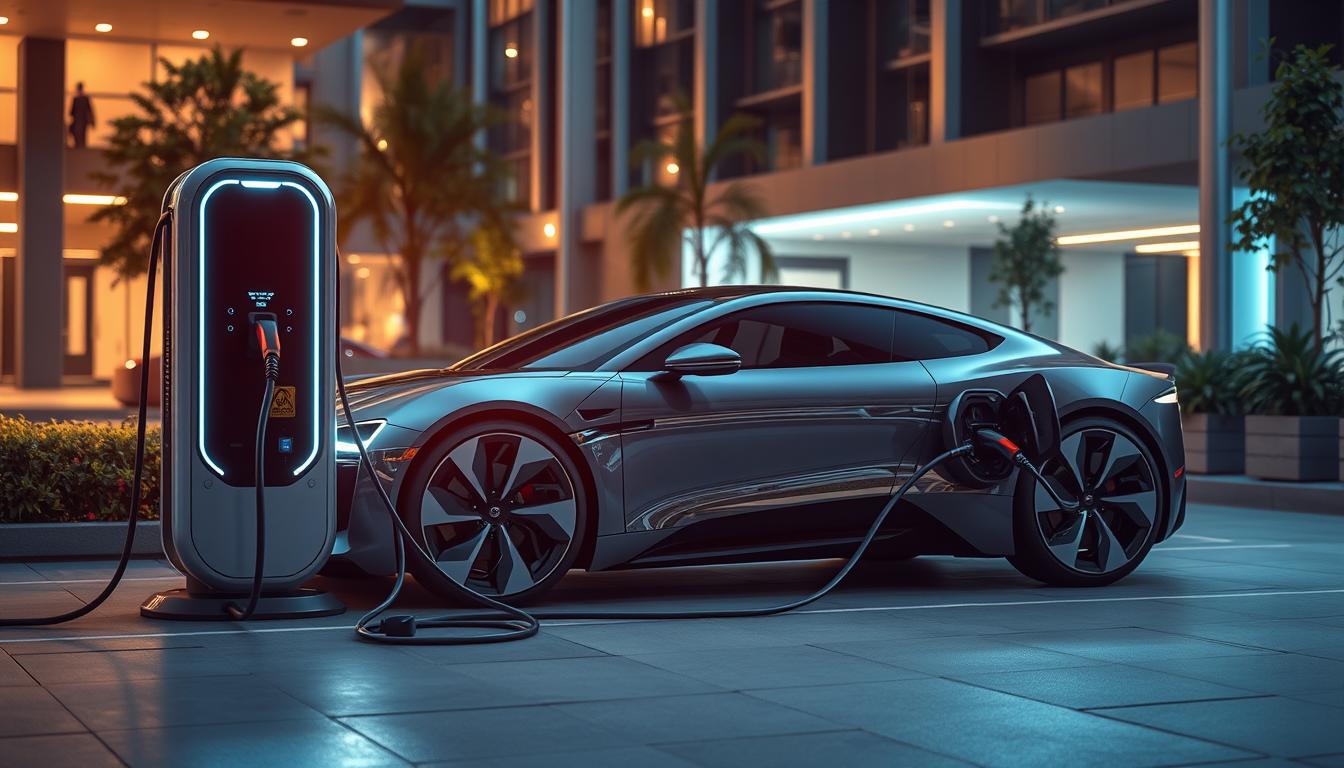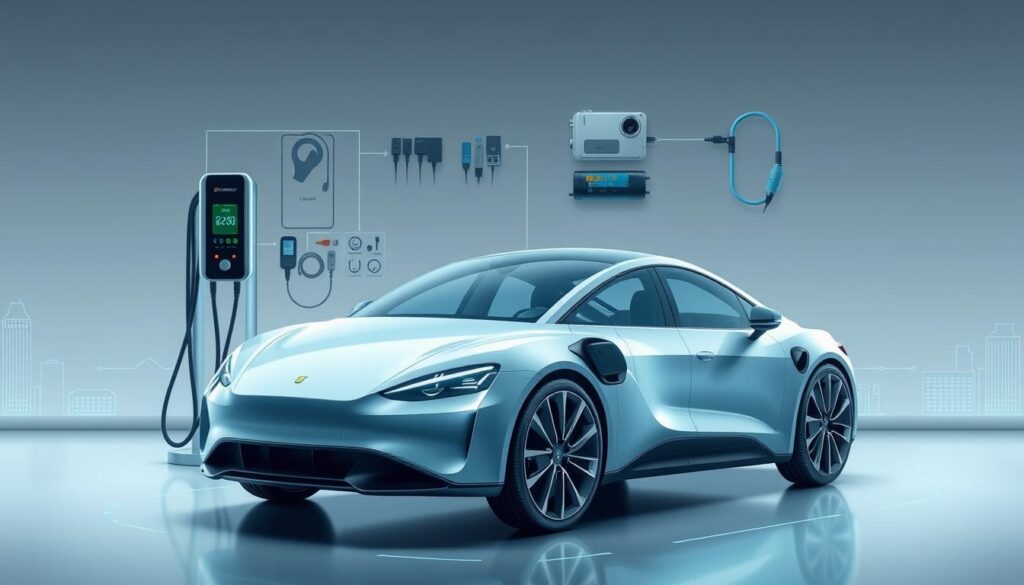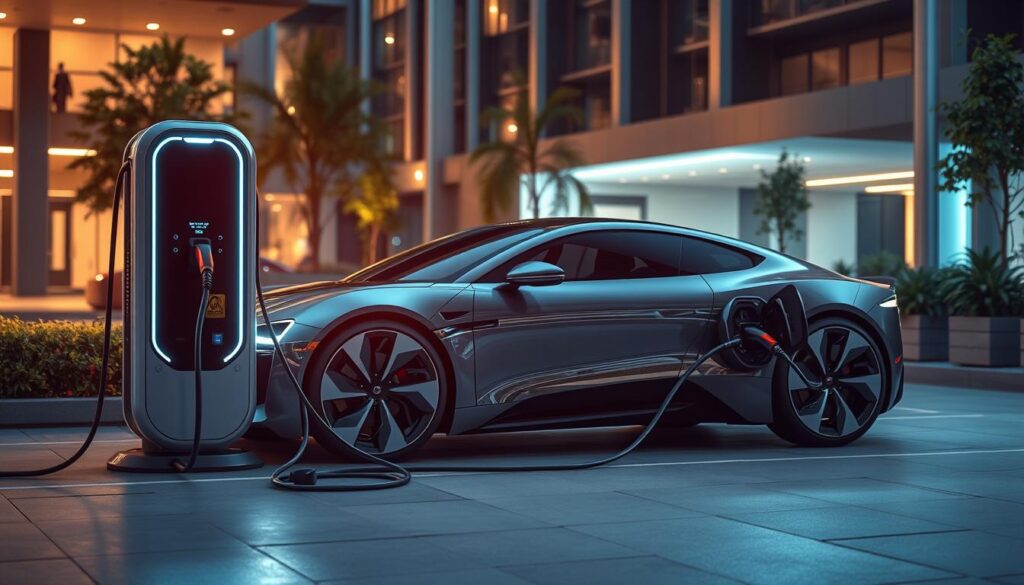

Ever thought about how electric and hybrid cars stay powered? As we move from gas to electric, knowing about vehicle charging systems is key. This intro covers the basics of how these systems work and what you need for your automotive charging system.
With more electric cars on the road, like the nearly 113,600 charging spots in the U.S. by January 2022, understanding charging system cars is more important. New tech and eco-awareness are changing charging systems. This affects our daily lives and the planet’s future.
Join us as we explore car charging systems, their parts, types, and upkeep for the best performance.
Key Takeaways
- Knowing about car charging systems is key for your car’s reliability and performance.
- The shift from dynamos to alternators is a big step in car tech.
- Charging system cars are getting more common, with lots of outlets in the U.S.
- Keeping your car’s charging system in good shape means it lasts longer and works better.
- Understanding voltage and current helps manage your vehicle better.
Understanding the Basics of Car Charging Systems
Knowing how a car battery charging system works is key for keeping your vehicle running well. It makes sure your battery stays charged, which is crucial for your car to work right. By understanding the parts like batteries, alternators, and how they charge, you get a better idea of how they all work together.
The Role of Batteries in Charging Systems
Batteries are the core of any car’s charging system. They hold electrical energy from the alternator and give it to important parts when the car is off. This energy is what starts the engine and powers gadgets when the car isn’t running. It’s important to check on your battery’s health often to keep it working well for a long time.
Alternators vs Dynamos: How They Work
Most cars use alternators or dynamos to make electricity. Alternators, found in newer cars, turn engine energy into electricity. They adjust how much power they make based on how fast the engine is running. This makes them efficient and powerful enough to charge the battery and power the car’s electrical parts at the same time.
Dynamos, on the other hand, are older and make direct current (DC) power. They were good in older cars but are now mostly replaced by alternators because they’re more efficient.
The Process of Charging a Car Battery
Charging starts when the engine is on, letting the alternator make electricity. This electricity does two main things: it powers the car’s electrical systems and charges the battery. As the battery uses up energy, the alternator fills it back up. A good charging system keeps the battery’s voltage just right, avoiding problems from too little or too much charge.
Charging System Components

Knowing the parts of an automotive charging system is key for your car to run well. A good charging system keeps the battery charged and electrical parts working right. The main parts are the battery, alternator, and voltage regulator. Each is crucial for the system’s success.
Key Components of Automotive Charging Systems
- Battery: Gives the engine a start and powers things when the engine is off. It lasts about two to five years.
- Alternator: Turns engine energy into electrical power. It keeps the battery charged and powers the car’s electrical system.
- Voltage Regulator: Keeps the alternator’s voltage steady, between 13.5 to 14.5 volts. This ensures the battery is charged right without getting too full.
How Each Component Contributes to Charging
The alternator makes electricity when the engine is on. It changes AC power to DC power for the car’s 12-volt system. This is key for keeping electrical parts working.
The voltage regulator is important for managing the alternator’s voltage. It keeps the voltage stable. This protects electronic devices and the battery from damage from too much charge.
The battery works with the alternator and voltage regulator. Regular checks and upkeep are vital. This prevents problems like needing frequent jump-starts or seeing warning lights. Taking care of these parts ensures your car’s charging system works well.
Charging System Cars: Types and Technologies

The world of charging cars has seen big changes. Knowing the different types is key for charging cars well. Each type meets different needs, important for electric and hybrid cars.
Overview of Different Charging Systems
There are three main types of charging systems: Level 1, Level 2, and DC fast chargers. Each has its own power output and charging time:
- Level 1 Chargers: These give less than 2 kilowatts of power. They’re good for charging at home overnight. But, they charge slowly.
- Level 2 Chargers: They can give up to 19.2 kilowatts of AC power. Level 2 chargers can fully charge a car in a few hours. Sometimes, they can even charge a battery in under an hour.
- DC Fast Chargers: These are the fastest, charging a battery in under an hour. They use 40 to 400 kilowatts of power. They have different connectors like CHAdeMO, CCS, and Tesla’s connector.
This variety makes charging cars faster and more convenient. It meets different needs throughout the day.
Importance of Compatibility in Charging Technologies
Compatibility is key for charging cars efficiently. The CCS connector lets drivers use one port for many charging options. In 2022, only 1% of public EV charging ports in the U.S. were Level 1. But, about 80% were Level 2, and over 20% were DC fast chargers.
With federal funding, more DC fast charging is coming. This will make charging easier for everyone. EV Connect is leading in network charging solutions, meeting the growing need for strong charging systems.
Charging System Maintenance and Diagnostics
Keeping your vehicle’s charging system in good shape is crucial for its performance and life. Regular maintenance and accurate diagnostics can spot problems early. Knowing when to check your charging system is key to keeping your car reliable.
Signs Your Charging System Needs Attention
There are several signs that your charging system might be having trouble. Watch out for these:
- Dimming lights: If your lights flicker or seem dim, it could be a sign of a problem.
- Battery warning light: A light on your dashboard warning of a battery issue is a clear sign.
- Strange noises: Odd sounds from the alternator could mean there’s something wrong inside.
- Frequent jump-starts: Needing to jump-start your car often might mean your batteries or charging system need fixing.
- Electrical malfunctions: Problems with your car’s accessories, like the radio or air conditioning, could be due to power issues.
It’s important to do charging system diagnostics quickly if you notice these signs. Knowing that about 70% of problems are related to the battery can help you start fixing things.
Routine Maintenance Tips for Optimal Performance
To keep your vehicle’s charging system in top shape, follow these maintenance tips:
- Visual inspections: Look over the battery, alternator, and cables carefully. This can solve up to 80% of problems.
- Testing voltage: Make sure the charging system keeps a voltage between 13.3 and 14.7 volts when the engine is on.
- Battery cleaning: Clean battery terminals with special brushes to ensure good connections.
- Alternator checks: Check the alternator’s output; too much AC ripple can mean problems.
- Belt adjustments: Check and adjust belt tension to avoid about 15% of malfunctions.
By following these tips, you can greatly reduce the need for repairs or replacements. Regular diagnostics and maintenance can help keep your charging system running smoothly and extend its life.
| Common Issues | Percentage of Occurrence | Maintenance Recommendation |
|---|---|---|
| Batteries and connections | 70% | Visual inspection and testing |
| Belt tension problems | 15% | Tightening or replacement |
| Defective alternators | 10% | Replacement as necessary |
| Electrical issues | 5% | Regular electrical system checks |
Conclusion
Knowing how your car’s charging system works is key to keeping it running well. The battery, which needs to be replaced every 3-5 years, is a big part of this. If you notice things like flickering lights or slow power windows, it’s time to check things out.
Keeping your car’s charging system in good shape helps it last longer and makes driving better. With electric cars becoming more common, new ways to charge them are coming along. Things like RFID-based wireless charging are making charging easier and more efficient.
As electric cars become more popular, it’s important to keep up with the latest in charging technology. The Combined Charging System (CCS) is a good example of this. It helps meet different charging needs. By staying informed, car owners can make the most of their vehicles and enjoy the latest in charging system cars.
FAQ
What is the primary function of a car charging system?
A car’s charging system makes electricity to charge the battery and power parts. It’s key for all cars, gas or electric. This ensures the car runs well.
How does the charging system affect vehicle performance?
It gives power to the ignition, lights, and electronics. If it fails, the engine may not start well, lights dim, and the battery dies.
What components are involved in the automotive charging system?
The main parts are the alternator, battery, voltage regulator, and wiring. They work together to keep the right voltage and charge the battery.
How can I diagnose issues with my vehicle’s charging system?
Use a multimeter to check battery voltage. Look for alternator damage and check connections. Signs of trouble include dashboard lights, hard starts, and alternator noises.
What maintenance is required for car charging systems?
Regular checks include battery water level, terminal cleaning, and alternator and belt inspections. This helps catch problems early.
How often should charging systems be replaced?
Replace parts like alternators and batteries when needed or as recommended. Batteries last 3-5 years, alternators 7-10 years, depending on use.
Are there different types of charging systems for electric vehicles?
Yes, electric and hybrid cars use various charging systems. These include Level 1, Level 2, and DC fast charging. It’s important to match the car with the right charging station.
Why is it important to understand charging system technologies?
Knowing about charging systems is vital for car performance and reliability. As cars become more electric, staying updated helps with maintenance and upgrades.







